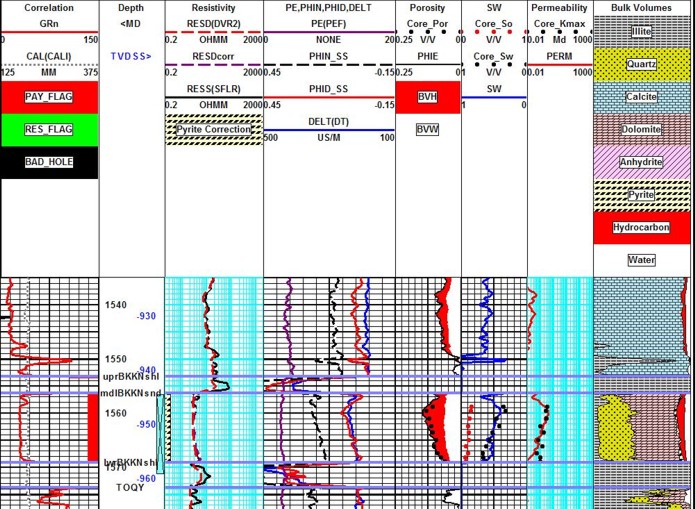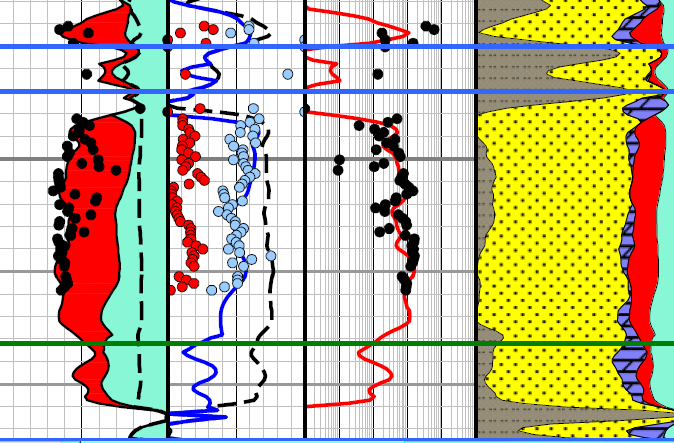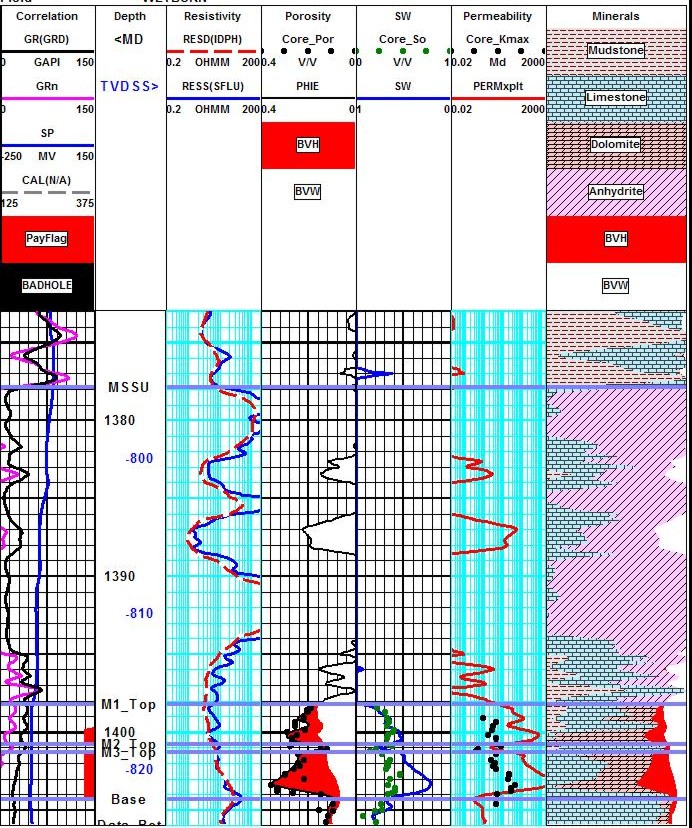|
 CALIBRATING Water
Saturation
CALIBRATING Water
Saturation
During coring, moveable
hydrocarbons are flushed from the core and replaced by mud
filtrate, leaving residual oil and irreducible water. Some
of the irreducible water may be replaced by mud filtrate as
well. During recovery and transport of the core, the
majority of the water will drain out, leaving residual oil
and irreducible water. The sum of residual oil saturation
plus irreducible water saturation is usually less than 1.0,
the balance being the moveable oil saturation. In older
reservoirs with many years of production, there may also be
some moveable water. This will also be flushed by the mud
filtrate. To appreciate the meaning of the core saturations,
it is important to know the history of a reservoir relative
to the when the core was cut.
In petrophysical analysis, we utilize the core water
saturation as a guide to the irreducible water saturation in
a reservoir above the transition zone. In a core, the
difference between residual oil and water saturation is
usually assumed to be the moveable oil fraction of the
reservoir fluids, when the reservoir is at initial
conditions. The core water saturation is usully assumed to
be close to the irreducible water saturation.
In older reservoirs, no longer at initial conditions,, there
may be some moveable water as well as the moveable oil. This
can often be seen on the log analysis results depth plots
where log analysis saturation is higher than core water
saturation. The excess water saturaton is a measure of
potential water production.
If corroboration of water
saturation is required, air-brine capillary pressures should be
taken, along with electrical properties, from at least a dozen core
plugs with some variations in porosity or pore geometry. This will
resolve the initial irreducible water saturation question. A
reservoir simulation history match would be
needed to resolve the question of moveable water saturation.
Cores
taken in oil based mud give a better view of irreducible water, as
these muds do not displace the water.
The main use for core analysis oil saturation is to estimate
minimum possible residual oil saturation, and to assist in locating
gas-oil and oil-water contacts. Gas and water zones have low
residual oil, unless they were once oil zones (recently or in
earlier geologic time). Oil saturation from core analysis is quite
useful in tar sand and sometimes in heavy oil evaluations, where
flushing is minimal.
 CALIBRATING LOG ANALYSIS TO CORE SATURATION EXAMPLES
CALIBRATING LOG ANALYSIS TO CORE SATURATION EXAMPLES
These examples demonstrate the close match between log analysis
water saturation and core analysis water saturation. It works most
of the time, especially with cores cut after the mid 1980's,
provided they have been handled according to best practices. If it
doesn't work, or doesn't seem to make sense, forget it and move on.

Bakken “Tight Oil” example showing core porosity (black dots), core
oil saturation (red dots). core water saturation (blue dots), and
permeability (red dots). Note excellent agreement between log
analysis and core data. Separation between red dots and blue water
saturation curve indicates significant moveable oil, even though
water saturation is relatively high. Log analysis porosity is from
the complex lithology model and lithology is from a 3-mineral PE-D-N
model using quartz, dolomite and pyrite.


Sandstone example (left) and carbonate example (right) showing close
match of log analysis and core analysis water saturation. Black dots
are core porosity and permeability. Light blue dots are core
analysis water saturation, which fall close to log analysis
saturation curve (blue). Red dots on sandstone example are residual
oil saturation, showing lots of moveable oil between the water
curve, even though the water saturations are quite high (due to poor
pore geometry).
 Moveable Hydrocarbon EXAMPLE
Moveable Hydrocarbon EXAMPLE
This example shows a comparison of residual oil from core in a
depleted zone (M1 interval) and in a bypassed zone (M3 interval).
The Sor from core equals (1 - SW) from log analysis, so there is no
moveable oil in the M1. The close match suggests that most of the
saturation parameters (A, M,
N, RW@FT) and porosity are reasonably well calibrated. Since the
world abounds with depleted zones (most are well known to the well
operators) this test should always be made to confirm SW parameters
where ever core data is available.

Computed results for carbonate example. Note higher water saturation
on M1 compared to M3. M3 is bypassed pay. M1 is depleted oil. Dots
are core data. Note that residual oil on core in M1 matches
calculated
Sor = (1 - SW). In M3, Sor on core is less than (1 - SW) from log
analysis, so there is moveable oil in
M3 interval but not in M1. Calibration to core permeability needs more work to get a
decent match.
|

